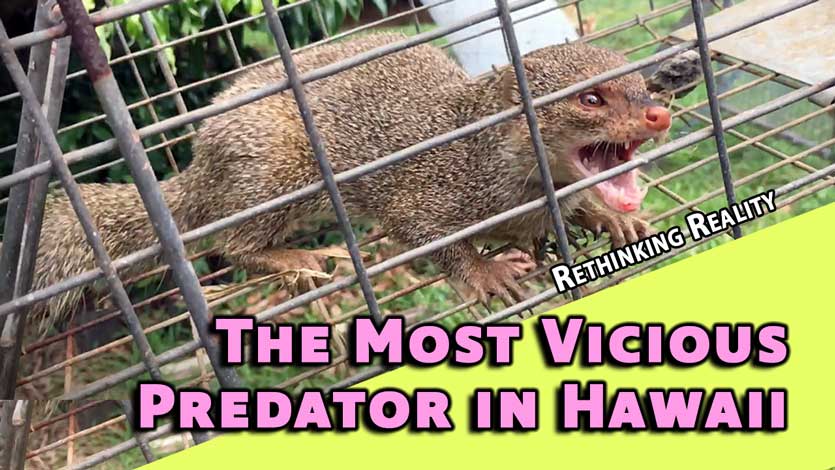
Table of Contents
Mark Daniells, our farm manager and I are going to tell you a heartfelt story of saving a young chick’s life from near death and starvation.
First of all, I would like to say this; we all have the power of love within ourselves to heal the sick and help others when we really want to put the effort out, or if we feel we can try to help.
As I said in the video: “If you have got a little bit of wisdom, if you have got a little bit of time and if you have a little love in you – you can save somethings life.”
There is a truly magic moment in bringing a living creature back from near dead back to a super healthy life.
As I was saying in the video, this little orphaned chick was discovered by Mark (total luck), chirping in the back of the warehouse. The baby chick was apparently abandoned by the wild chicken’s mother who already was taking care of 9 others that hatched days before.
These two babies that were left in the nest, because they must not have hatched at the same time as the others did. If Mark was not lucky to hear and then go investigate to find the baby, it would have died that day for sure.
Chickens do not feed their babies directly as other birds do who feed the babies until they are ready to feed themselves. The baby chicks are on their own as soon as they are born, and have to get their own nourishment.
Mom and dad do protect them very well and guide them into the areas where they may be able to find food such as worms, grass, insects and grains etc.
The mom would have been left to starve to death to take care of the others she had. Nature is sometimes brutal when you really look closely.
I am sure mom had to have pushed the babies off the high shelf where the nest was, to get her babies to start to feed and have some water.
Once the babies are on the ground she has a full time job trying to keep an eye on them from the predatory mongoose that are in high numbers throughout Hawaii, and to get them to start feeding.
Out of the 9-12 babies most chickens have at one time; usually only 2-3 of them will get to adulthood. The mongoose predators are always on the prowl for an easy meal. I have seen the mothers battle it out with the mongoose.
The roosters, or the dad’s, are the protector of the brood. Mothers are also protectors and can be nasty to intruders if provoked. I have seen many times the father and mother chase the mongoose aggressively away.
Mongoose are sneaky creatures and ruthless killers, and are very sneaky hunters that will wait for the babies to get close to them, and then ambush them one at a time.
If you have not seen the video I did on “The Most Vicious Predator in Hawaii” take a watch to see how these toothy predators are destroying/eating every bird and lizard they can catch.
The mongoose are apex predators and are also egg eaters, so they will eat all of the eggs in a nest or wait till they are attracted by the babies chirping in the nest, and will climb up the tree and eat the babies alive.
Read the description of that video to learn more about the mongoose in Hawaii, and the destruction they have caused by decimating the native bird populations.
This is the mother of all of the babies including the one I am raising now. As you can see she has her hands full with the clan she is raising and protecting from the mongoose. These are wild chickens that are all around the property.
This is the other baby chick that was with the one we saved from starving to death. Mom laid her eggs in this glass bowl from an old ceiling fan and it was on a high shelf in the warehouse about 6 ft off the ground.
Talk about luck when Mark heard a lite chirp up in the shelves. He went over to investigate and found 1 baby that was deceased and the other just about ready to die.
Mark drove up to my house with the chick in his hand and said “Do you think we can do anything for this poor little guy that has been abandoned by his mother?”
I said: “Let’s see what we can do”. So, I went into action and inspected the little chicky poo – the body of the baby was very cold and you could tell it was severely dehydrated. The baby bird did not look like it had a chance in heaven to come back to life from barely lifeless.
Quickly I had Mark hold the bird in his hands to try and warm the cold lifeless chick up a little. I ran in the house to find a warming light and an extension cord and hooked it up right away. Meanwhile, Mark breathed his warm breath on it and held it in his hands.
Once we got the heat lamp/light bulb (we used an old school incandescent bulb that gives off heat – not an LED because they do not really radiate any heat) plugged in, I had Mark hold the bird in his hands as close as he could to the warm bulb.
I went and looked for an eye dropper, cleaned it out and started to try and give the baby some water but it would not take any at all. So I had to pry its mouth open and slowly force a few drops down the chicks throat one at a time, making sure I did not aspirate or put water in the baby’s lungs.
The baby chick was so weak. If I would shove water down into the bird’s lungs – that would be a disaster, so I carefully got a few drops down at a time.
Then we started to get the babies circulation going again, giving it little massages all throughout the muscles to wake them back up again with some life giving blood.
I force fed the baby some more water every few minutes, but she was not responding at all and looked like the baby was dying and not going to make it.
I took the baby and blew my breath sort of abruptly and forcefully several times on it and shook her lightly and then she started to move, roll her head and roll her eyes a little… at least we started to get a little movement out of her from a lifeless body.
We kept on giving her a little more water, then a little more stimulation with the body massage and Mark was still holding her and warming her up. She seemed to get a little more active and have more life force.
The baby was really cold being in the glass bowl, so it took quite a bit of time to slowly warm her up again to operating temperature.
I figured the baby had been in the cold nest glass bowl with the other orphan for a few days without any food or water, and was slowly dying of dehydration and zero food.
So, number one was to get her heated back up again to functional temperature, then get enough water into the baby so the system can turn on again.
We spent about 20-30 minutes of constant warming the baby up and stimulating it with massage, as well as giving it many drops of water, and it was a task for sure.
The baby bird was just a day or two old and had hardly any feathers to keep it warm. It was so delicate and fragile we had to be very careful not to hurt it just by holding it.
Now we are into about 25-30 minutes of working with her and the little one was still not looking like it was going to make it. The bird almost looked like it was delirious or drugged and could not hold its head up and keep its eyes open.
Most people would have quit by now and said: “at least we tried…”, but I know from the past of saving other animals’ lives that if you keep trying you may have another shot with success.
The bird was lying down on its side in the heat lamp, and about 15 more minutes in – the miracle of life came to action and the little baby woke up from its coma and looked at me, and got up from the floor and started walking around 🙂
I was the first person for the bird to see, so the imprinting took place and I became the little ones mommy and daddy 🙂 Mark was also there to see all of this happening in real time.
What a beautiful joy it brings us to save a life that was destined for death, and on the brink of its last few breaths.
To bring an animal, or any life-form back from the edge of death is truly a miracle indeed.
We will keep you informed on her progress in weeks to come. I found out the baby chick was a hen doing some research online, and found out the arrangement of feather patterns for males and females are different from one another. It is very easy to tell if you have a hen or a rooster at a very young age (see below).
Female versus Male Babies – How Can You Tell The Difference?
You can see if the baby chicks are male or female just by looking at the shape of the wings.
The male baby birds look like they have all of the same size feathers, or are in all one straight line. As you can see in the picture below, the male has a one step curve to the wings.
On the female feathers, the wings have a two step shape, or they look like they have two sizes of feathers.
Eating Her First Feast Of Plenty – A Red Earthworm
2 days old and she is eating a large worm on her own. She loves worms and moths and will eat as many as you give her 🙂
We put out a video a few days ago on all of our social platforms asking people for name suggestions, and Mahalo for all of the responses and suggestions we got 🙂
I looked through hundreds of comments and a few of them were really good, but the one that really stood out to me was “Little Orphan Annie”. She is an orphan and I really connected with the 1932 movie when I was a young child watching that film on the TV at home with the family.
So, her new name will be Little Orphan “Annie” 🙂 We will see what nicknames come out of it, and I am sure this long name will get abbreviated somehow. I have been calling her “Annie O”, short for “Orphan Annie” 🙂
I will put out more videos with her progress coming up.
It’s that time of the evening again, – to feed all of the animals at the sanctuary which of course are my best and most loved non-human friends.
See more updates on our Instagram and TikTok accounts as well.
Hope you enjoy this “Heal The Sick & Raise The Dead – The Story Of Our New Chicken Friend” Video 🙂
Dr. Robert






